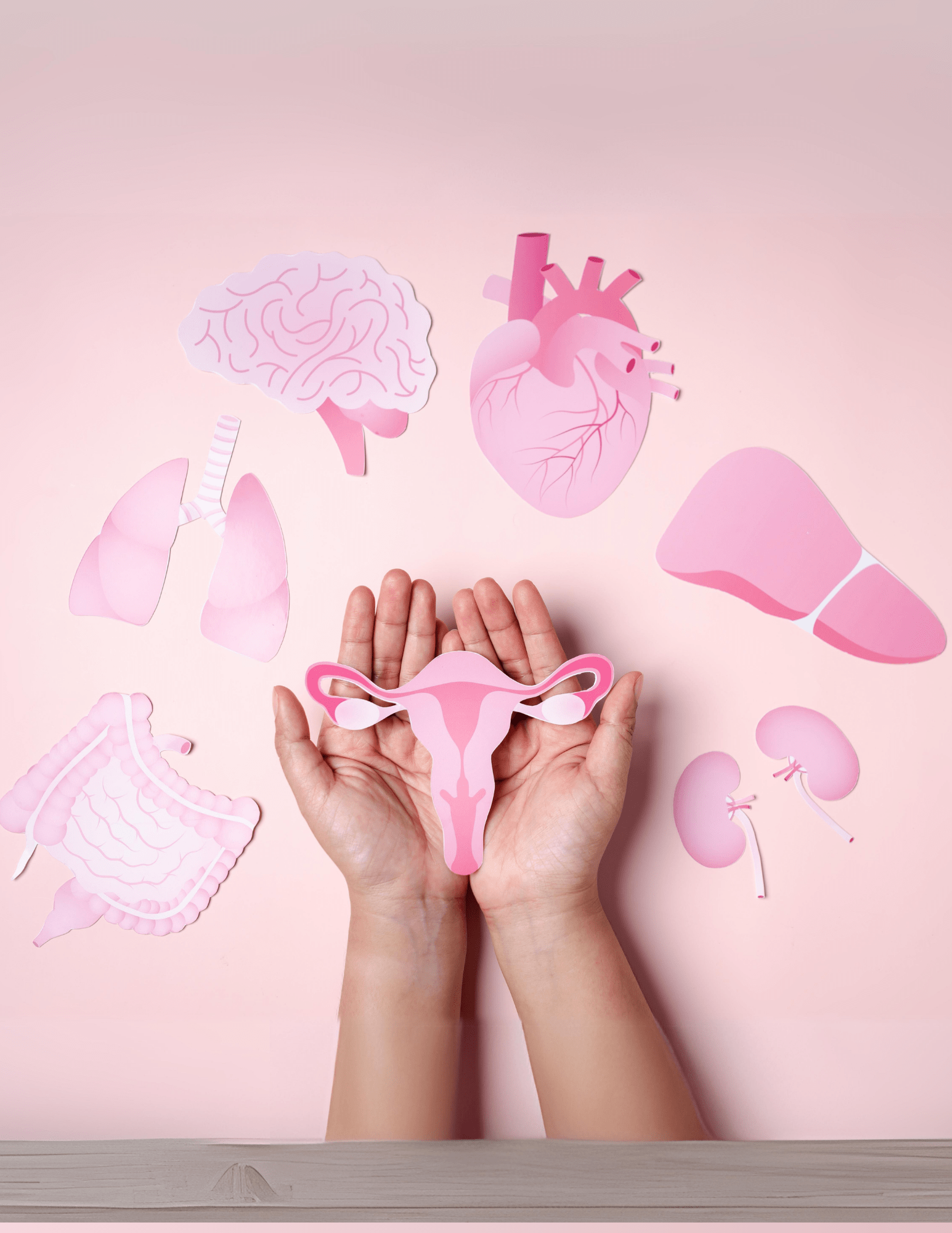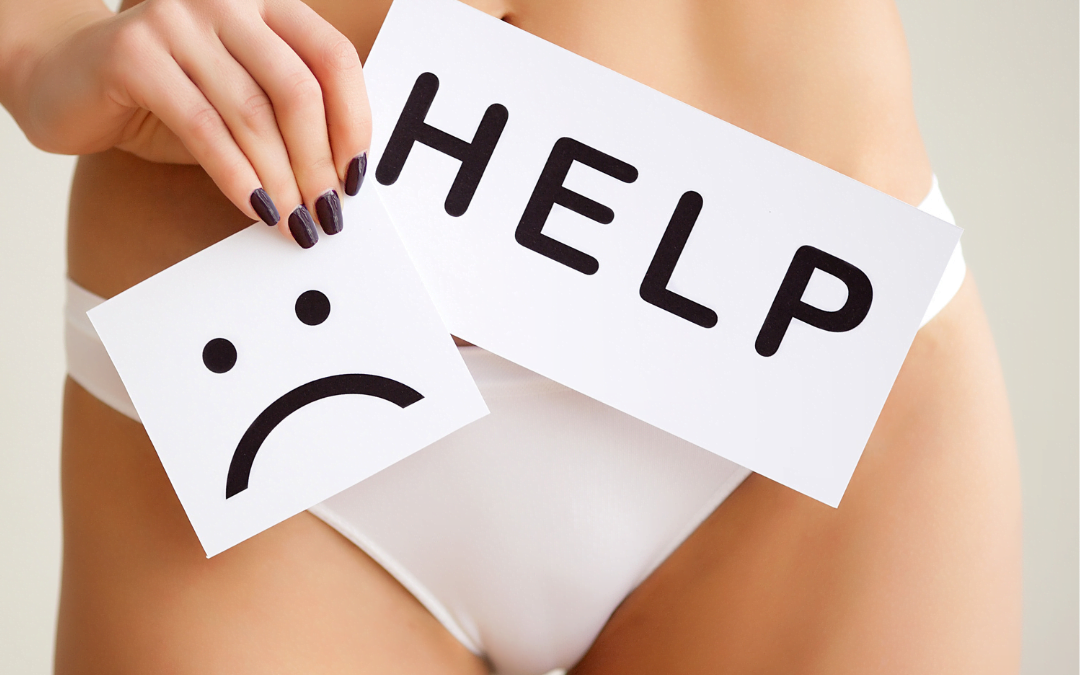The information provided in this blog post is for educational purposes only and is not intended as medical advice. Always consult with a qualified healthcare provider before making any changes to your diet, exercise routine, or medical treatment plan. We are not responsible for any adverse effects or consequences resulting from the use of any suggestions, products, or procedures discussed in this article.

You might feel less alone and embarrassed by knowing that about 75% of females will experience at least one vaginal yeast infection in their lifetime. These infections negatively impact our quality of life – they are uncomfortable, frustrating, and cause a solid dose of stress.
First of all, if you’re reading this it likely means you have symptoms that resemble a yeast infection. If so, I’m so sorry! It’s truly the worst. It’s so embarrassing to be itchy in public, to have weird discharge coming out of your vagina, to be intimate with your partner. Even worse if you are one of the unlucky ones that keeps having a yeast infection again and again; each time you think you got rid of it, it comes back with a vengeance.
In this blog I’m going to help you understand what a vaginal yeast infection is, if you actually have one (or if it’s something else), the holistic view on why you have it, and how to get rid of it once and for all. If you don’t have time to read through it all right now, you can skip to the section you need (but if you have time, read it all! I’d like to think it’s all useful information ![]() )
)

Symptoms
An overgrowth of Candida albicans causes a variety of symptoms. The symptoms and severity differ from person to person and can include:
- Itching and irritation of the vaginal tissues
- Burning sensation (I once had a client tell me that her downstairs bits were burning so badly that she had to go sit on ice to ease the pain!)
- Thick, white discharge (like cottage cheese)
- Redness and swelling
- Pain and soreness

Root Causes
It is helpful to ask why there is an overgrowth of Candida albicans in the first place. If we can figure out why, then we can find a solution to decrease the overgrowth and restore balance amongst the citizens of Vagina City.
1. Antibiotics & Hormone Imbalance
You remember that delicate balance I mentioned earlier? It can be thrown off from things that kill off the microorganisms that keep the Candida in check. You can think of it like over-hunting the predators that eat deer. With the lack of predators, deer overgraze, which destroys vegetation and disrupts forest regeneration. Some common examples of microorganism hunters include:
- Antibiotics
- Hormonal imbalance: A hormonal imbalance is not a root cause in itself. Some common culprits that can lead to a hormonal imbalance include lifestyle factors (discussed later on) and hormonal contraception.
2. Sugar
When we eat food, we absorb the useful parts and excrete waste and byproducts (yes, I’m talking about poop). Candida does something similar to this; it eats sugar and excretes certain byproducts. These byproducts can irritate the vaginal lining, causing burning and itching sensations. So the more sugar the yeast has to eat, the more byproducts it will produce.
3. Biofilms
Biofilms are microorganisms that act like security guards for Candida. If biofilms develop, they protect Candida from the body’s immune response and antifungal treatments that try to destroy the Candida overgrowth.
Biofilms can develop in the following situations:
- repeated or incorrect antifungal use
- a physical environment in the vagina that is warm, moist, and has an increased pH (e.g. due to the use of certain hygiene products)
- when the balance of Vagina City is upset. For example, from hormonal changes, antibiotics, poor diet
- a weakened or compromised immune system (see next)

4. Weakened Immune System
When one type of microorganism starts to get too powerful in the body, the body’s immune system sends little soldiers to keep them in check. But if the body has a weakened or compromised immune system, it is unable to keep up and respond in a way that returns balance to Vagina City.
How Are Yeast Infections Diagnosed?



Your gynecologist should work with you to choose the appropriate tests. It is important to get testing done to rule out any other cause like an STI.
1. Patient History
- Symptom Review: itching, burning, discharge, and discomfort during urination or intercourse
- Medical History: previous yeast infections, use of antibiotics, hormonal changes (e.g., pregnancy, menstrual cycle), and any underlying medical conditions (e.g., diabetes, immunosuppressive disorders)
2. Pelvic Examination
Check for signs of infection such as redness, swelling, and discharge. A speculum may be used to view the vaginal walls and cervix.
3. Laboratory Tests
- Vaginal Swab: To identify the presence of Candida and to determine the specific type
- Microscopic Examination: To determine if there is a yeast infection
- Culture: Helps in confirming the diagnosis and identifying the specific Candida species
- pH Test: Can be used to rule out another type of infection such as BV or trichomoniasis
4. Additional Testing
Sometimes there are more advanced tests done, for example susceptibility testing if there is suspicion of antifungal resistance. We won’t go into those tests here, but you can speak with your gynecologist if you get to this point.
Conventional Treatments
Where are we told to go when faced with a yeast infection? The gynecologist. They can test to make sure it’s actually a yeast infection, and prescribe an antifungal in hopes of destroying the overgrowth that causes symptoms.
Here’s an overview of standard OTC and prescription medications for yeast infections:
Over-the-counter (OTC) Antifungal Medications:
- Clotrimazole (Lotrimin, Mycelex)
- Miconazole (Monistat)
- Tioconazole (Vagistat)
Prescription Antifungal Medications:
- Fluconazole (Diflucan)
- Butoconazole (Gynazole-1)
- Terconazole (Terazol)
In one poll, 70% of females surveyed found antifungal treatment satisfactory in the short-term for alleviating symptoms. What’s interesting to me is this satisfaction rate drops significantly (down to 50%) long-term; many females said they had to have several doctors visits and different meds before finding something that works. This might be because, similar to bacteria and antibiotics, repeated use of all the medications listed above can potentially lead to fungal resistance.
That can be months with no symptom relief while trying to find a solution! Personally, I spent over a year visiting doctors and trying different antifungals and antibiotics, none of which worked for more than a couple weeks. I cannot explain the level of frustration I felt going to specialists that not only couldn’t provide solutions, but exacerbated the problem.
In addition, gynecologists aren’t trained on holistic or alternative treatments (like probiotics and dietary changes), which leaves a significant gap in care.
My hope with this blog is to fill in that gap by providing you with options that you are in control of, and that work long-term.
Holistic Approach
What are the Benefits of a Natural approach?
Conventional antifungal medications can sometimes cause irritation or other adverse effects. Many females therefore choose a natural approach over conventional treatments due to their desire for fewer side effects and overall health benefits. Natural, holistic approaches support the body’s immune system and restore balance of microorganisms in both the gut and vagina, which also reduces the risk of recurrent infections.
Natural remedies can offer additional health benefits like improved digestion and immune function. They can lead to sustainable, long-term health improvements, as they address the root cause rather than just treating the symptoms.
How long will the yeast infection take to go away with a holistic approach?
Is it super easy to get rid of a yeast infection? Like most things in life, it depends. In general, it will be harder the longer you’ve had the infection, the more extreme it is, and how your lifestyle and diet currently is. For me, I had a yeast infection for over a year before I implemented the correct treatment. During that year I tried antifungals and antibiotics and kept my lifestyle (i.e. diet, stress, and alcohol) the same. Because of this, it took a solid 4 months to get rid of it in a way where it wouldn’t come back. For those who are reading this and thinking, “That’s way too long, there’s no way I can wait 4 months for relief!”, don’t worry. I had symptom relief after only a couple of weeks. The changes I continued to apply throughout the 4 months was to ensure that my body was stable enough to prevent the infection from coming back. At the time of writing this, I implemented those holistic changes 4 years ago and the infection hasn’t been back since. So there’s hope! You just need to put in some work. If anyone tells you there is a magic pill or solution, they are lying and likely just trying to sell you something.
But, in an effort to remain positive, if you’ve only had an infection for some days or weeks, it should clear up pretty quickly so long as you don’t aggravate it with certain lifestyle habits or antibiotics.
All that said, let’s get to it.
Holistic Changes to Make
Diet
1. Sugar
If you remember from earlier, Candida eats sugar. The more sugar it has, the more it thrives. However, I do not encourage my clients to “reduce” or “eliminate” certain foods from their diet because it causes the brain to perceive a lack or want of food. Instead, I encourage my clients to view dietary changes as “replacing” one type of food with another. In this case, replacing sugary foods with vegetables.
Here is a list of sugary foods and beverages that should be greatly or entirely replaced until the infection is resolved:
Sources
1. Sweets and Desserts: Cut back on candies, chocolates, cookies, cakes, pastries, and other sweet treats. These items are often high in refined sugars, which can promote yeast overgrowth.
2. Soda and Sweetened Drinks: Avoid soda, sweetened teas, energy drinks, and other beverages with added sugars. These drinks are typically loaded with sugars that can feed yeast.
3. Fruit Juices: Even though they contain natural sugars, fruit juices can be high in fructose and should be limited. Opt for whole fruits instead, which have fiber to help moderate sugar absorption.
4. Sugary Snacks: Steer clear of granola bars, protein bars, and other snack bars that contain added sugars. Check labels carefully, as many seemingly healthy snacks can have hidden sugars.
Hidden Sources
1. Processed Foods: Many processed foods contain added sugars, including sauces, dressings, and marinades.
2. Breakfast Cereals
3. Breads and Baked Goods
4. Dairy Products: Flavored yogurts and some milk alternatives, like flavored almond milk or soy milk, often contain a lot of added sugars.
Natural & Artificial Sweeteners
1. Honey, Agave, and Maple Syrup: Use them sparingly or avoid them altogether during an active yeast infection.
2. Artificial Sweeteners: Some artificial sweeteners can disrupt gut flora and potentially contribute to yeast overgrowth. Opt for natural, low-calorie alternatives like stevia or monk fruit if needed.
Fruits
1. High-Sugar Fruits: Limit your intake of high-sugar fruits like bananas, grapes, and mangos during an active infection. While fruits are healthy, it’s better to focus on lower-sugar options like berries, apples, and citrus fruits in moderation while you’re trying to restore balance to your vagina.
Instead, add more of these:
1. Replace sugary foods with non-starchy vegetables:
- Leafy greens- spinach, arugula, lettuces, etc.
- Cruciferous vegetables- broccoli, brussels sprouts, cauliflower, etc.
- Other non-starchy veggies- there are so many but a few include bell peppers, cucumber, zucchini, mushrooms, radishes, and artichokes
2. Herbs & Spices- all, but especially garlic and turmeric
3. Probiotic-rich foods – yogurt, kefir, fermented vegetables, lacto-fermented vegetable juices (without added sugars)

Hygiene
1.
Avoid staying in wet clothes, underwear, or bathing suits for extended periods, as moisture creates a breeding ground for yeast. Make sure to change into dry clothes as soon as possible after swimming or exercising.
2.
Refrain from using soap, including intimate washes, in the vagina and on the labia. Washing with water is enough. These products can disrupt the natural pH balance of your vagina, making it easier for yeast to thrive.
3.
Know that lubricants and sperm can alter vaginal pH. Consider using natural alternatives like aloe vera gel and condoms until the infection clears up.
4.
Avoid scented products: scented tampons, pads, powders, sprays, and bubble baths. These products can irritate the vaginal area and disrupt its natural balance.
5.
Wear Breathable Underwear: Choose underwear made from natural fabrics like cotton, which allows for better air circulation and reduces moisture build-up.
6.
Avoid tight-fitting underwear and synthetic fabrics that can trap heat and moisture. Wash new underwear before wearing them.
7.
Avoid tight clothing during an infection. Try wearing loose-fitting clothes during the day when possible. At night, sleep without underwear to give everything a chance to breathe!

Stress
Chronic stress can weaken the immune system, disrupt the balance of good bacteria, and increase inflammation. Managing stress therefore is a vital part of overcoming a yeast infection.
Take inventory of the stressors in your life, both physical and emotional. This can include things like lack of sleep, illness, being overworked, or relationship stress.
Choose stress management techniques that work for you. For me, yoga is a huge stress release. Focusing on my breath through movement is a form of meditation and successfully takes me out of my head and back into my physical body. However, some of my clients simply don’t get any benefit out of yoga. Find what works for you and implement stress management techniques into your daily routine. Some examples include:
Daily physical movement
Breathing techniques
Meditation/Journaling/Yoga: Anything that helps calm your mind
Don’t hesitate to seek help from a professional counselor or therapist
Connect with nature
One of my favorite parts about my job is helping clients find solutions that work for their personalities. If you’ve tried a few things and just can’t stick with any or don’t find that any work, maybe it’s time to get some help.

Symptom Relief
While a holistic approach involves addressing the root causes of the infection, sometimes our symptoms are too irritating to wait for the above changes to take effect. It’s hard to stick with food changes instead of popping a pill while your vagina is on fire. It’s near impossible to sit and meditate when the downstairs itch is literally the only thing you can think of. Here are some natural options to help with immediate symptom relief while you wait for the root cause solutions to kick in:
- Boric acid suppository
- Tea tree oil suppository
- Probiotics
- Cool bath (though I don’t recommend applying ice like my client did in the anecdote above!)
Remember, these are for symptom relief and shouldn’t be used long-term. As your symptoms get better, it’s super important to continue with your holistic changes. If you use the above symptom relief options like you would use a conventional treatment, your yeast infection will likely come back.


Prevention
You got sick for a reason; a yeast infection doesn’t just happen without cause. Maybe your diet is too high in sugar. Maybe your stress is unmanaged. Maybe you have a weakened immune system. Whatever the case, the yeast infection is your body telling you that a change is necessary to get healthy and STAY healthy.
Let’s say your diet includes way too much sugar and not enough vegetables. You get a yeast infection and apply the above dietary changes until the infection goes away. Great. Now what do you think will happen if your diet goes back to exactly how it was before? You’ll very likely get another infection. You will have to find the right balance of food groups for your body to sustain health.
If you’re having a hard time with recurring yeast infections and finding a balance, consider working 1:1 with a holistic coach. You can book a free call here.
And there you have it! By following the tips outlined, you can tackle the root causes and prevent future occurrences. Remember, maintaining a balanced diet, practicing good hygiene, and managing stress are key to overcoming yeast infections once and for all. Stay positive and committed to your journey—you’ve got this!
